The Checker Maven
The World's Most Widely Read Checkers and Draughts Publication
Bob Newell, Editor-in-Chief
Published each Saturday morning in Honolulu, Hawai`i
Contests in Progress:
The Grandmaster Gem --- Solved!
Way back in December, we presented Brian Hinkle's Grandmaster Gem --- a problem which up to that point had been solved by only two people, and had baffled many master class players. Since we published it, only one correct solution has been received; but there have been numerous pleas for help!
We are at long last pleased to provide the solution, written and annotated by problem author and Checker Maven contributor Brian Hinkle.
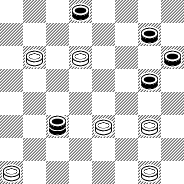
WHITE
White to Play and Win
1. 10-7 A 2x11 2. 24-20 B 22-26 C 3. 9-6 26x19
4. 6-2 D 19-15 E 5. 2-7 F 15-18 6. 29-25 G 18-15
7. 25-21 15-18 8. 21-17 18-15 9. 17-13 15-18
10. 13-9 18-15 H 11. 9-5 15-18 12. 5-1 18-15
13. 1-6 I 15-18 14. 32-27 J 18-22 15. 27-23 22-26
16. 23-18 26-22 K 17. 18-14 22-26 18. 14-9 26-23
19. 9-5 23-19 20. 5-1 19-23 21. 1-5 23-19
22. 5-9 19-23 23. 9-14 23-19 24. 14-17 19-23
25. 6-9 23-19 26. 9-14 19-24 27. 14-18 L 24-19
28. 17-22 19-15 29. 18-23 15-19 30. 22-26 19-24
31. 26-30 24-28 32. 7-10 28-24 33. 10-14 24-28
34. 14-18 28-24 35. 18-22 24-28 36. 22-26 28-24
37. 26-31 24-28 38. 31-27 28-24 39. 27-32 24-27
40. 23-18 27-24 41. 32-28 M 24-27 42. 28-24 27-31 N
43. 30-25 31-26 44. 25-21 26-31 45. 21-17 31-26
46. 17-14 26-31 47. 14-10 31-26 48. 10-7 26-31
49. 18-22 White Wins.
A - This 1. 10-7 pitch is the only move that wins with full plans to sacrifice another piece! It would be natural to try to keep the extra piece with 1. 10-6 or 1. 9-5 but Black will move 16-20 against either move and get a man-down draw. Another wrong try is
1. 24-20 16-19 2. 23x16 12x19 3. 20-16 8-12 4. 9-5 22-18 5. 16-11 18-15 6. 11-7 2x11 7. 5-1 15x6 8. 1x10 19-23 Drawn.
So Grasshopper, choose wisely: would you rather have a man-up draw or would you have the courage to sacrifice 2 men and get a man-down win?
B - Temporarily locking down Black's 4 pieces on 8, 11, 12, and 16.
Note: after 2. 24-20, this setting makes a beautiful twin with the terms: Either to play, White wins. Can you see how White would win if it were White's move?
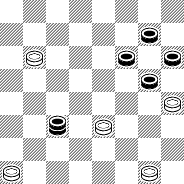
WHITE
White to Play and Win
C - Black may as well chase the piece on 23 now and hope white moves 23-18? which would allow Black to draw.. Delaying with 22-17 will result in the same 2x4 cramp shown in the trunk line.
D - White is now a man-down after sacrificing a second piece. Does this position look like a white win to you? It is, believe it or not!
E - White gets the 2x4 bind regardless of where the Black king moves next.
F - The 2x4 cramp + "the move" = man down win. In this position "the move" means the total number of pieces in the columns up from squares 29, 30, 31 and 32 will total 5 when it is White's turn. If White doesn't have "the move", then it is only a draw!
G - White must crown the piece on 29 first. Starting the piece on 32-27 will allow Black to slip away with a draw with 18-22 7. 27-23 22-26 8. 23-18 26-23 9. 18-14 16-19 10. 7x16 23-18 11. 16x23 18x27... Drawn.
H - Going into the double corner makes for a quick win...18-14 11. 9-6 14-9 12. 6-1 9-5 13. 1-6 5-1 14. 6-10 1-5 15. 32-27 5-9 16. 27-23 9-5 17. 10-14 5-1 18. 7-10 1-5 19. 10-6 5-1 20. 6-9 1-5 21. 14-18 5x14 22. 18x9 White Wins.
I - White must park the second king here on square 6 so a winning swap can be threatened later as the piece on 32 moves up the board to crown.
J - With the White king placed on square 6 it is now time to get a third king.
K - If 26-23, 6-10 is the important swap that White needs to threaten.
L - Same as Ben Boland's Famous Positions p.135 after the 3rd move, colors reversed. Although not mentioned by Boland, it is important to note that if it were Black's turn, then it is only a draw. Having the 4x2 bind is not enough to win. Again, note that there are 5 pieces in the winning side's system ... a high five to the winner!
M - The only move to win.
N - 42. 27-32 18-15 43.11x18 20-4 44. 12-16 4-8 45. 18-22 8-12 46. 16-20 24-19 47. 32-27 12-16 48. 27-32 19-15 49. 32-27 15-18 White Wins, Famous Positions, colors reversed.
This checker problem was created after I noticed that the early 23-18 Switcher game between Alex Moiseyev and Louis Cowie played at the 2002 Ohio State tournament could have resulted in a strange man-down position. Later, I noticed this was the Fugitive King win in Famous Positions and I mentioned this to Rich Beckwith; it was an observation I made when I was going through a period without using any computer software.
Fascinated with this discovery, I decided to find the earliest possible setting of the Fugitive King win and then disguise it in a natural setting where 2 men must be sacrificed in order to get the pretty man-down win. It took about 10 hours of work to set it up just right after I understood everything, including "the move", using KingsRow. Back in June 2004 none of the checker programs with the 8 piece database could solve it so many players assumed it was a draw! Ed Gilbert confirmed it was a win with KingsRow's 9 piece database.
I congratulate the only 3 players in the world who solved it: Alex Moiseyev, Jim Morrison and Albert Tucker.
Almost everyone else thought this position was set up wrong, especially players who used checker software with the 8 piece database. This underscores a growing dependency on computers. It turns out that computers were not needed to solve this puzzle at all and in this case they just got in the way. The main thing you needed to solve this puzzle was knowledge of the Fugitive King win published in Ben Boland's Famous Positions.
Runups:
1. 11-15 21-17 2. 9-13 23-18 3. 8-11 25-21 4. 6-9 27-23 5. 1-6 32-27 6. 3-8 30-25 7. 9-14 18x9 8. 5x14 24-19 9. 15x24 27x20 10. 6-9 22-18 11. 13x22 26x17 12. 11-15 18x11 13. 8x15 17-13 14. 4-8 13x6 15. 2x9 31-26 (Louis Cowie played 25-22? against Alex Moiseyev in the 2002 Ohio State tournament and lost.) 16. 8-11 26-22 17. 15-19 23x16 18. 12x19 22-17 19. 9-13 25-22 20. 11-15 20-16 21. 19-24 28x19 22. 15x24 (Left as a Black win in Master Play p. 351-P. Black will use knowledge of the Fugitive King ending to complete the win. From this point on, there is no draw escape for White.) 16-12 23. 24-27 12-8 24. 27-32 8-3 25. 32-27 3-8 26. 27-24 8-3 27. 24-19 3-8 28. 19-15 8-3 29. 15-11 29-25 30. 11-15 3-8 31. 15-19 8-3 32. 19-23 3-8 33. 23-26 8-3 34. 7-11 3-7 35. 11-16 7-2 36. 16-20 2-6 37. 14-18 6x15 38. 18-23 ... Black Wins.
1. 11-15 22-18 2. 15x22 25x18 3. 8-11 29-25 4. 4-8 24-20 5. 12-16 28-24 6. 10-15 26-22 7. 9-14 18x9 8. 5x14 31-26 9. 8-12 23-18 10. 14x23 26x10 11. 6x15 21-17 12. 1-5 17-14 13. 2-6 32-28 14. 3-8 14-10 15. 7x14 27-23 16. 5-9 24-19 17. 15x24 28x19 18. 9-13 22-18 19. 6-9 25-21 20. 13-17 30-26 21. 9-13 18x9 22. 17-22 26x17 23. 13x22 9-6 White Wins.
If you enjoyed this problem, then let me know.
If you have any additional run ups or associated positions to share, then please email me at sbhinkle@charter.net.

The Checker Maven Reader's Survey!
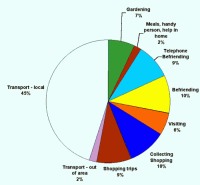
Thank you in advance!
Note: as of 01 June 2005 the survey is complete and the results have been published. However your comments and suggestions are always welcome; just email us at any time.
Mayday! Mayday!

We don't think you'll need help with this month's speed problems, but solving them fast is the goal. How well can you do? Try them out and click on Read More for the solutions.
(We are always in need of speed problems. If you have any that you'd like us to publish, please contact us using the contact link in the left column.)
Problem 1: Very Easy
Problem 2: Easy
Thanks to Brian Hinkle, an oversight in the setting and solution of Problem 2 has been corrected.
[Read More]But Is It Worth Your Job?

Here's the runup to the critical position:
11-16 23-18 10-14 18-15 16-19 22-17 7-10 24-20 9-13 26-22 5-9 30-26 8-11 15x8 4x11 27-23 2-7 23x16 12x19 32-27 11-15 20-16
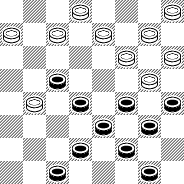
BLACK
Black to Play and Win
A brilliancy indeed, but is it worth your job?
Richard Pask's Revised 'Key Openings'

Our thanks to Mr. Pask for the opportunity to place this work before the checker playing public.
The Masked Man is Back in Town

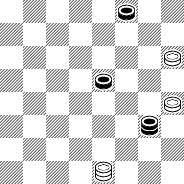
WHITE
White to Play and Draw
Check your solution, and learn the identity of the composer, by clicking on Read More.
[Read More]A Draw Move Is To Be Made Every Time
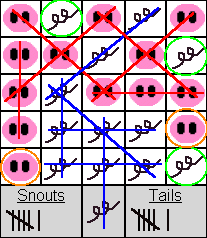
Here at the New Mexico office of The Checker Maven we're continuing to muse over articles published in 1926 in The Morris Systems Checkerist just prior to the 2nd International Match, played between the US and Great Britain over the board, back in those Golden Days. But things were not simple then, either; the magazine tells of quite a heated controversy in selecting the final two American players for the twelve-player team. We've simply got to requote in part a short piece that the magazine reproduced from the Lynn Item:
"...They have selected 10 players for American team and these are Heffner, Banks, Horr, Gonotsky, Long, Ginsberg, Reynolds, Lieberman, Hanson and O'Grady. There are two more to be chosen and they talk of such men as Bradford, Duffy, Lieber and Dossett.
"It would have been better had the team been held down to 10 men a side, which was the number 20 years ago. The 10 now selected are all good players although there are one or two who should do a lot of practicing from now until the opening of the match; and then play safe and sure instead of taking new lines which they have picked out for themselves and which they may think will trip their opponents. Cooks are not to be thought of in this kind of play but a draw move is to be made every time."
The piece was written by John H. Finn, who, obviously, would not have been of a mind with the likes of draughts champion Derek Oldbury or American football coach Vince Lombardi.
The Fun Shot in the Single Corner Opening: Conclusion
(Please see our previous article for the first part of this story.)
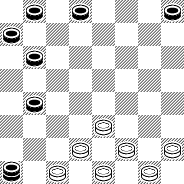
WHITE
White to Move - and Win?
26-22.
Was that a smug look on Marvin's face? Could our hero possibly be thinking, well, less than charitable thoughts about getting even after being heckled by Billie and some of the others? Would Marvin J. Mavin do such a thing?
Marvin smiled, and said, rather loudly, "Hmmph. Well, son, that was a logical move, but unfortunately, it won't get you a win!"
Billie seemed taken a bit aback. He thought for a moment, remembering his teacher's instructions to be "on your best behavior," and then replied with a snicker, "Wanna bet, beer belly?" There was a ripple of laughter from the audience, although clearly the adults in charge seemed rather unhappy with this turn of events.
"Well, young man, I imagine I had better teach you a lesson," said Marvin in his most authoritarian tone.
The game then continued along, with Marvin and Billie moving the pieces about on the demonstration board:
17x26 31x22 1-6 28-24 4-8 23-19 6-10 19-16 8-11 16x7 2x11 24-19 9-14 32-28 5-9 27-23 11-15 30-25 15x24 28x19 9-13 25-21 13-17 22x13 29-25 13-9 25-22 9-6 22-18 21-17 18x27 17-13 Drawn.
(Click here for animation.)
"And now, my fine little friend, what do you think?" asked Marvin.
"Uh, I, well, uh, ya know, I 'spose mebbe it's like, ya know, a draw or sumthin'.....," stammered Billie.
"And INDEED IT IS! It's a DRAW!" exclaimed the hero of the Doublejumpers. "Shall I show you how you should have played it?" he added.
Billie's face had that "I'd rather be anywhere but here" look, and the crowd didn't seem very happy, either.
"Of COURSE you want to know!" continued Marvin. He reset the pieces (to the state diagrammed at the beginning of this article) and then showed the following play (neglecting, of course, to attribute this winning line to the KingsRow computer program):
28-24 1-6 24-19 9-13 19-15 17-21 15-11 29-25 26-22 25x18 23x14 13-17 31-26 6-9 14-10 9-13 26-23 17-22 10-7 22-25 7-3 5-9 23-19 2-6 3-7 9-14 19-15 13-17 7-10 6-9 27-23 25-29 10-6 9-13 6-9 White Wins.
(Click here for animation.)
"It's not a simple win, and White has to play it correctly, but the win is there IF you are good enough to figure it out!" Marvin concluded. But Billie had slunk back off the stage, muttering to himself something about how computers make funny-looking moves.
Surprisingly (or perhaps not so surprisingly) there was no applause. The young audience was filled with frowns and sullen looks. Their school champion, Billie, had been shown up by Marvin. Now, at first one by one, and then a few at a time, and finally in large groups, the audience began to silently exit the auditorium. In just a few minutes, there was no one left but Marvin, a few teachers, and the Principal, Mr. I. B. Cylindrical. This latter august personage went up to Marvin, shook his hand, and said, "Um, yes. Well. Um, thanks. Yes, thanks. For visiting our school. Um, the children, yes, the pupils, well. It's clear how much they admire you."
There was a long, quiet pause. "Um, seems cold for April, don't you think? Yes, um, cold. It feels chilly in here." Mr. Cylindrical continued with a few more equally apt remarks as he accompanied Marvin out of the auditorium. Marvin then said his farewells and crossed the parking lot, where his 1973 Volkswagen Beetle was waiting to take him to the nearest bar.
Crime Does Not Pay
A little while back we lamented the presence of computer-using cheaters on the major online play sites. We recently came across an article published over 80 years back in the Morris-Systems Checkerist magazine that highlights a similar problem, and how one cheater got what he had coming. We've reprinted the article below.

Falls Into Graceless Trap After Double Move
Not always, however, is it profitable for the sly-hander to make his moves unseen, and the man who thinks he is "getting away with it" will find now and then that he has dug a pit for himself too deep for escape.
We happened into a rather amusing demonstration of this not long ago while watching a player of good repute in a park exhibition where he was handling a number of boards simultaneously. As the exhibition player went from board to board we noticed that one of his opponents near us advanced a piece as if to test the position, then glanced up to see if he had been observed. When the exhibition player appeared at this board again the opponent made his regular move, but the piece he had advanced a minute before remained where he had placed it. The exhibitionist was plainly surprised. Evidently he had remembered the earlier position. We saw him eye his man with a keen glance, but said nothing, made his move and then went on to the next board.
Later, in the end game, the position on the board was as shown (below).
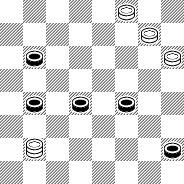
"Double Mover"--Black
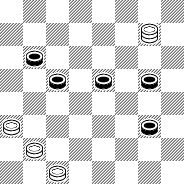
White--Exhibition Player
White to Move and Win
Had the "double mover" been content with his first illegal move he might have gained a draw, but when he repeated his offense, he apparently aroused the wrath of the checker g-ds and brought himself to swift and sorry doom.
How did the Exhibition Player give the "Double Mover" his comeuppance? Solve the problem and click on Read More for the solution.
[Read More]The Manchester Draughts Club
It's a Wednesday evening, and you've just finished a day at one of the editorial offices of The Checker Maven. You're in the mood for a good game of checkers and you wouldn't mind a beer as an accompaniment.
If you're at our Santa Fe office, you might head out to your favorite cantina for chips and salsa, and a Dos Equis Amber to go along with them, but the only checker competition you'll find is on the internet.



The club was created to provide a venue for casual cross-board play, as a welcome alternative to correspondence play, which had been the only local option for nearly a decade. But under the inspiration of Frank McDonald, the club soon introduced competitive play, which quickly rose to a high level of skill and achievement.
Internally, the club sponsors both 3-move and go-as-you-please (freestyle) leagues and knockout tournaments. Winners from these competitions qualify as challengers for the Lancashire 3-move and freestyle championships each year. As of this writing (April 2005) Frank Bednall is the reigning 3-move champion, while Donald Oliphant holds the freestyle crown. In addition, the club puts on two open tournaments each year, in memory of two former Lancashire players: the Arthur Jones 3-Move Tournament, played in the spring, and the Ronald Bumby Freestyle Tournament, played in the autumn.

Donald Oliphant, 3-Move Lancashire County Champion, and Melvyn Green, Challenger
Photo by Sue Reade

Lancashire South (Manchester) Win the 2003 British Counties Championship
From left: Matthew Eke, John Reade, Donald Oliphant, Melvyn Green, Eddie O'Gara
Photo by Sue Reade
To be sure, chips and salsa in Santa Fe is fine fare, and the sunset show on the beach in Waikiki is a great experience, but compared with quality over-the-board draughts play and a few pints of Robinson's, you know what our choice would be.

The Checker Maven is produced at editorial offices in Honolulu, Hawai`i, as a completely non-commercial public service from which no profit is obtained or sought. Original material is Copyright © 2004-2024 Avi Gobbler Publishing. Other material is the property of the respective owners. Information presented on this site is offered as-is, at no cost, and bears no express or implied warranty as to accuracy or usability. You agree that you use such information entirely at your own risk. No liabilities of any kind under any legal theory whatsoever are accepted. The Checker Maven is dedicated to the memory of Mr. Bob Newell, Sr.


